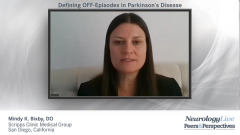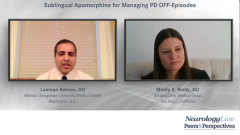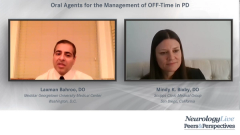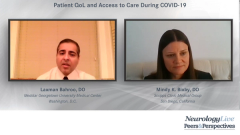
Sublingual Apomorphine for Managing PD OFF Episodes
Experts in the management of Parkinson’s Disease OFF episodes provide insight into the sublingual formulation of apomorphine hydrochloride and discuss differences in its safety and efficacy profiles.
Episodes in this series

Laxman Bahroo, DO: Because we’ve talked about apomorphine subcutaneous, let’s move on to apomorphine sublingual, which is the newest entrant into the OFF episode market for us. It’s our newest tool in our armamentarium of managing OFF episodes. Apomorphine sublingual is known as Kynmobi. Dr Bixby, please tell us a little about the dosing of Kynmobi, or apomorphine sublingual.
Mindy K. Bixby, DO: This medication is a rectangular strip. There are 5 different doses of this: It starts at 10 mg and ends at 30 mg. Based on opportunity for a patient to figure out exactly what works for them, a recommendation is to use the trimethobenzamide for treatment…possibly before the dose is used. It always starts at the 10 mg. That 10-mg strip is placed under the tongue. The first thing we always ask them to do is take a nice sip of water…so it will dissolve well, and we don’t have to wait too long.
They place it under the tongue, close their mouth, and wait. Usually, we ask them to wait and not swallow for a little bit of time, up to 3 minutes. Then they relax and make sure it’s gone, and then it’s live again within 10 to 15 minutes, full exposure within 30 minutes, and may last up to 90 minutes. It’s great. It’s 1 of those medications that once you get the right dose, they will be very effective between OFF episodes.
Laxman Bahroo, DO: I agree. It’s very important to know that there’s a dosage strength of 10 to 30 mg. Just as individuals would for apomorphine subcutaneous, they find the right dosing for them that gives them an on. Efficacy-wise, the time to full-on is as soon as 30 minutes, or 15 minutes was the first onset of on with slightly different data. The studies also show that administration must be done exactly the way you mentioned it: Individuals cannot have anything else in their mouth at that time. They cannot swallow. Otherwise, you will lose the medication to first pass metabolism. I like the idea of having them drink a sip of water to moisten their mouth because, as we know, many Parkinson patients suffer from excessive dry mouth…. I embargo them from doing anything else: no speaking, no eating, no reflexive swallowing—they just wait. It takes 3 to 5 minutes, which is not a long time for the medication to dissolve. But it’s important to understand that if you’re watching a clock, those 3 to 5 minutes can seem longer than you anticipate.
Mindy K. Bixby, DO: Absolutely.
Laxman Bahroo, DO: The interesting thing is the adverse-effect profile. Here, you have an option that’s not an injectable option. There is certainly an advantage to that. It’s self-administered, as you mentioned, and the strip is very portable. Because it’s sublingual, there seem to be some disadvantages that we should talk about. Some of the disadvantages include ones that we’re used to from Parkinson medication, such as nausea, are there. The recommendation is to have trimethobenzamide is there. What’s unique to this medication are the sublingual issues, such as oral ulceration, irritation of the tongue, and bleeding. Those are adverse effects that we must be aware of, which are not necessarily seen in the early initiation portion, but you tend to see it more with maintenance. Have you seen that?
Mindy K. Bixby, DO: Yes, I have. It’s rare, but it is in there. I want to make sure my patients are always aware of the possibility of this, simply because it may scare them if their mouth is a little bigger, if they have some redness around the tongue, if they’re noticing that they’re having some difficulty—even the paranesthesia and tingly numbness they may experience as well. I always want to make sure I talk to my patients before this in case there is a possibility. My patients tend to be astute: “What’s the adverse-effect profile?” We want to make sure we’re very clear about that. As time goes by with the newer drugs, we’re watching that possibility to see if there’s anything else that may have come out of the clinical trial. Mostly, I haven’t seen as many changes in the soreness or anything in the mouth. I have noticed that some people have nausea.
But it’s in the newer drugs. The verdict is still out regarding understanding it. But it is quite good at making it convenient for somebody just to have it in their pocket and be able to put it…when they’re out and about. That’s quite a convenient thing to have. The efficacy of turning on for 90 minutes—after the 30-minute moment—is wonderful for patients, especially if it’s the medication that they’re typically using or they’re having an OFF episode that they didn’t realize. It’s nice to have this opportunity.
Laxman Bahroo, DO: I agree completely.
Thank you for watching this Neurology Live® Peers and Perspectives®. If you enjoyed the content, please subscribe to the e-newsletters to receive upcoming programs and other great content in your in-box.
Transcript Edited for Clarity
Newsletter
Keep your finger on the pulse of neurology—subscribe to NeurologyLive for expert interviews, new data, and breakthrough treatment updates.



































